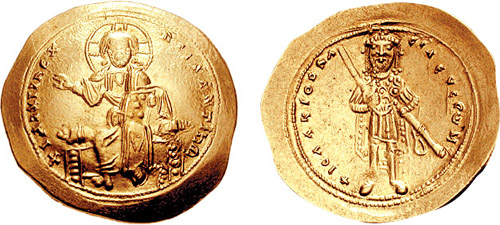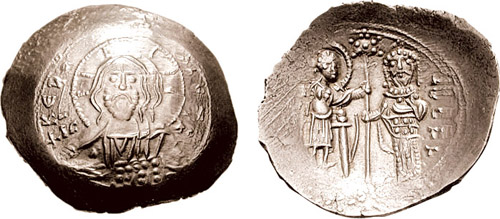Histamenon nomisma-Constantine VIII-sb1776.jpg on:
[Wikipedia]
[Google]
[Amazon]
 ''Histamenon'' ( grc-gre, Ż¤î╬╝╬╣¤â╬╝╬▒ß╝▒¤â¤ä╬Č╬╝╬Á╬Ż╬┐╬Ż '' ├│mismahist├ímenon'', "standard
''Histamenon'' ( grc-gre, Ż¤î╬╝╬╣¤â╬╝╬▒ß╝▒¤â¤ä╬Č╬╝╬Á╬Ż╬┐╬Ż '' ├│mismahist├ímenon'', "standard
 Initially, the two coins were virtually indistinguishable except in weight. During the later reign of Basil II (), the ''tetarteron'' began to be minted in a thicker and smaller form, while the ''histamenon'' became correspondingly thinner and wider. Only during the sole rule of
Initially, the two coins were virtually indistinguishable except in weight. During the later reign of Basil II (), the ''tetarteron'' began to be minted in a thicker and smaller form, while the ''histamenon'' became correspondingly thinner and wider. Only during the sole rule of
 Starting with Michael IV, who was a former money lender, the gold content began to be increasingly lowered and the coins debased. After a period of relative stability in circa 1055ÔÇô1070, the gold content declined dramatically in the disastrous 1070s and 1080s. The '' michaelata'' of Michael VII Doukas () still contained some 16 carats of gold, but by the time of Alexios I Komnenos (), the ''nomismata'' struck contained almost no gold at all. Thus, in 1092, Alexios I carried out a comprehensive monetary reform, replacing among others the debased gold coins, both the ''histamenon'' and the ''tetarteron'', with a new high-quality gold issue, the '' hyperpyron''.
Henceforth, and for the duration of the Komnenian monetary system (12thÔÇô13th centuries), the term ''stamenon'', due to its association with scyphate coins, came to be applied as a blanket term to the similarly concave billon and copper coins ('' trachea'') issued by the Byzantine Empire.
Starting with Michael IV, who was a former money lender, the gold content began to be increasingly lowered and the coins debased. After a period of relative stability in circa 1055ÔÇô1070, the gold content declined dramatically in the disastrous 1070s and 1080s. The '' michaelata'' of Michael VII Doukas () still contained some 16 carats of gold, but by the time of Alexios I Komnenos (), the ''nomismata'' struck contained almost no gold at all. Thus, in 1092, Alexios I carried out a comprehensive monetary reform, replacing among others the debased gold coins, both the ''histamenon'' and the ''tetarteron'', with a new high-quality gold issue, the '' hyperpyron''.
Henceforth, and for the duration of the Komnenian monetary system (12thÔÇô13th centuries), the term ''stamenon'', due to its association with scyphate coins, came to be applied as a blanket term to the similarly concave billon and copper coins ('' trachea'') issued by the Byzantine Empire.
 ''Histamenon'' ( grc-gre, Ż¤î╬╝╬╣¤â╬╝╬▒ß╝▒¤â¤ä╬Č╬╝╬Á╬Ż╬┐╬Ż '' ├│mismahist├ímenon'', "standard
''Histamenon'' ( grc-gre, Ż¤î╬╝╬╣¤â╬╝╬▒ß╝▒¤â¤ä╬Č╬╝╬Á╬Ż╬┐╬Ż '' ├│mismahist├ímenon'', "standard oin
Oin, Óin or OIN may refer to:
Folklore and fiction
* Óin, son of Gróin, a Dwarf from J. R. R. Tolkien's writings, companion of Thorin Oakenshield
* Oin-Oin, a character of Swiss folklore
Other
* Open Invention Network, a company specialising i ...
) was the name given to the gold Byzantine '' solidus'' when the slightly lighter ''tetarteron The ''tetarteron'' ( el, Ż¤î╬╝╬╣¤â╬╝╬▒¤ä╬Á¤ä╬▒¤ü¤ä╬̤ü¤î╬Ż, "quarter oin) was a Byzantine term applied to two different coins, one gold circulating from the 960s to 1092 in parallel to the ''histamenon'', and one copper used from 1092 to the second ...
'' was introduced in the 960s. To distinguish the two, the ''histamenon'' was changed in form from the original ''solidus'', becoming wider and thinner, as well as concave ( scyphate) in form. Later usually shortened to ''stamenon'' (Greek: ¤â¤ä╬Č╬╝╬Á╬Ż╬┐╬Ż), it was discontinued after 1092. In the 12th and 13th centuries, the name ''stamenon'' came to be applied to the concave billon and copper '' trachea'' coins.
Establishment
Ever since EmperorConstantine I
Constantine I ( , ; la, Flavius Valerius Constantinus, ; ; 27 February 22 May 337), also known as Constantine the Great, was Roman emperor from AD 306 to 337, the first one to convert to Christianity. Born in Naissus, Dacia Mediterranea ...
() introduced it in 309, the Byzantine Empire's main coinage had been the high-quality '' solidus'' or '' nomisma'', which had remained standard in weight (4.55 grams) and gold content (24 carats) through the centuries. Emperor Nikephoros II Phokas (), however, introduced a new coin, the '' omismatetarteron'' ("quarter oin
Oin, Óin or OIN may refer to:
Folklore and fiction
* Óin, son of Gróin, a Dwarf from J. R. R. Tolkien's writings, companion of Thorin Oakenshield
* Oin-Oin, a character of Swiss folklore
Other
* Open Invention Network, a company specialising i ...
) which was 2 carats (i.e. about 1Ôüä12, despite its name) lighter than the original ''nomisma''. The latter now became known as the ''histamenon'', from the Greek verb , "to stand up", implying that these followed the traditional standard. The reasons for this change are not clear; Byzantine chroniclers, however, suggest fiscal motives, reporting that Nikephoros collected the taxes as before in the ''histamenon'' while paying back with the ''tetarteron'', which was officially rated as equal in value to the full-weight coin.
 Initially, the two coins were virtually indistinguishable except in weight. During the later reign of Basil II (), the ''tetarteron'' began to be minted in a thicker and smaller form, while the ''histamenon'' became correspondingly thinner and wider. Only during the sole rule of
Initially, the two coins were virtually indistinguishable except in weight. During the later reign of Basil II (), the ''tetarteron'' began to be minted in a thicker and smaller form, while the ''histamenon'' became correspondingly thinner and wider. Only during the sole rule of Constantine VIII
Constantine VIII Porphyrogenitus ( el, ╬ܤë╬Ż¤â¤ä╬▒╬Ż¤äß┐ľ╬Ż╬┐¤é ╬á╬┐¤ü¤ć¤ů¤ü╬┐╬│╬ş╬Ż╬Ż╬̤ä╬┐¤é, ''K┼Źnstantinos Porphyrog├ęnnetos''; 960 ÔÇô 11/12 November 1028) was ''de jure'' Byzantine emperor from 962 until his death. He was the young ...
() did the two coins become iconographically distinct as well. By the mid-11th century, the ''tetarteron'' measured 18 mm wide and its weight apparently standardized at 3.98 grams, i.e. three carats less than the ''histamenon'' or ''stamenon'' (a name first attested in 1030), which now measured 25 mm in diameter (as opposed to 20 mm for the original ''solidus''). In addition, under Michael IV the Paphlagonian (), it began to be minted in a slightly concave (scyphate) form, possibly to increase the thin coin's strength and to make it less easily bent. Flat coins were still struck at times, but scyphate ones came to predominate from Constantine IX () on and became standard under Isaac I Komnenos
Isaac I Komnenos or Comnenus ( grc-gre, ß╝ޤâ╬▒╬Č╬║╬╣╬┐¤é ╬Ü╬┐╬╝╬Ż╬Ě┬ş╬Ż¤î¤é, ''Isaakios Komn─ônos''; ÔÇô 1 June 1060) was Byzantine emperor from 1057 to 1059, the first reigning member of the Komnenian dynasty.
The son of the gene ...
(). These concave coins were known as ''histamena trachea'' or simply ''trachea'' (¤ä¤ü╬▒¤ç╬ş╬▒, "rough, uneven") from their shape.
Debasement and abolition
 Starting with Michael IV, who was a former money lender, the gold content began to be increasingly lowered and the coins debased. After a period of relative stability in circa 1055ÔÇô1070, the gold content declined dramatically in the disastrous 1070s and 1080s. The '' michaelata'' of Michael VII Doukas () still contained some 16 carats of gold, but by the time of Alexios I Komnenos (), the ''nomismata'' struck contained almost no gold at all. Thus, in 1092, Alexios I carried out a comprehensive monetary reform, replacing among others the debased gold coins, both the ''histamenon'' and the ''tetarteron'', with a new high-quality gold issue, the '' hyperpyron''.
Henceforth, and for the duration of the Komnenian monetary system (12thÔÇô13th centuries), the term ''stamenon'', due to its association with scyphate coins, came to be applied as a blanket term to the similarly concave billon and copper coins ('' trachea'') issued by the Byzantine Empire.
Starting with Michael IV, who was a former money lender, the gold content began to be increasingly lowered and the coins debased. After a period of relative stability in circa 1055ÔÇô1070, the gold content declined dramatically in the disastrous 1070s and 1080s. The '' michaelata'' of Michael VII Doukas () still contained some 16 carats of gold, but by the time of Alexios I Komnenos (), the ''nomismata'' struck contained almost no gold at all. Thus, in 1092, Alexios I carried out a comprehensive monetary reform, replacing among others the debased gold coins, both the ''histamenon'' and the ''tetarteron'', with a new high-quality gold issue, the '' hyperpyron''.
Henceforth, and for the duration of the Komnenian monetary system (12thÔÇô13th centuries), the term ''stamenon'', due to its association with scyphate coins, came to be applied as a blanket term to the similarly concave billon and copper coins ('' trachea'') issued by the Byzantine Empire.
References
Sources
* * * * {{Byzantine coinage Gold coins Coins of the Byzantine Empire